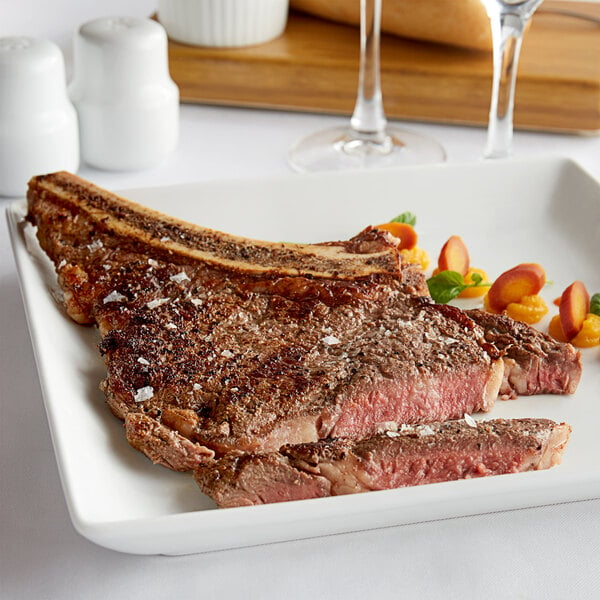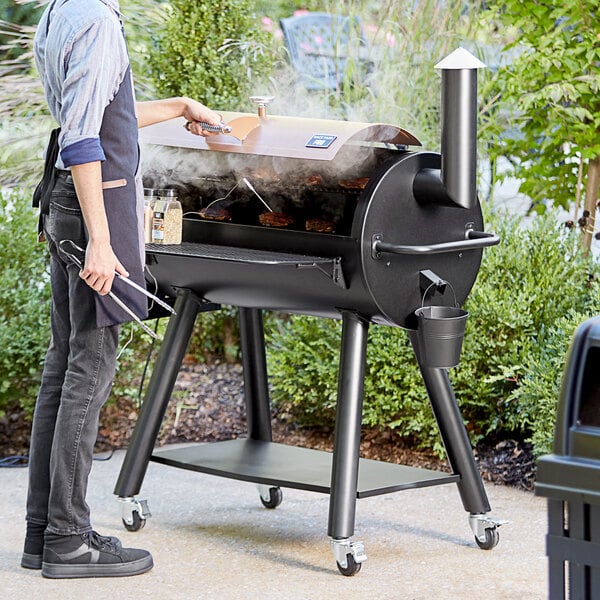American cuisine is a melting pot of global spices, cooking methods, and traditions from its diverse population. But American-style barbecue is a United States original. Tough cuts of meat are smoked till tender and served with sauces ranging from sweet and spicy to tart and tangy. Low and slow is the national anthem, but the flavor notes vary by region. We break down the different types of American barbecue so you can recreate each tradition at your restaurant. Shop All Smokehouse and Barbecue Supplies Use these links to learn more about the different types of American BBQ: BBQ Definition 4 Main Types of BBQ Lesser-Known Styles of BBQ Vegan Barbeque BBQ Sauce Styles History of BBQ in America What Is Barbeque? Barbeque is a style of indirect cooking that uses live fire and smoke to heat food. Most countries and regions have a distinct barbecue tradition. In North America, pitmasters BBQ foods by roasting or smoking them over wood or charcoal at low temperatures for several hours, transforming whole roasts and tough cuts into tender, succulent pieces of meat. Because the cooking process, equipment, and meals are so entwined, they’re all referred to as BBQ. You can accurately barbeque ribs, get the heat going on the barbeque, and enjoy a plate of barbequed chicken. Grammarians would tell you barbeque is a verb, noun, and adjective. American pitmasters know it’s a way of life. What Are the 4 Types of BBQ? In the American tradition, there are four prominent BBQ regions: Kansas City, Carolina, Memphis, and Texas. These four barbeque styles represent the most recognized regional renditions of smoked meat. You’ll find each style's techniques, rubs, and sauces copied across the U.S. From their cuts of choice to their sides, read on to learn what makes each of the four major American BBQ regions unique. 1. Kansas City Style BBQ Kansas City style BBQ offers a smorgasbord of slow-smoked meats rubbed down in a sweet seasoning and slathered in a thick, sugary sauce. Brown sugar is the base ingredient of Kansas City rub (traditional recipes call for a two-to-one ratio of brown sugar to paprika). Pitmasters keep their heat low to prevent the caramelizing sugar from charring and blackening their meats. While beef, pork, and poultry are all fair game, burnt ends are the hallmark of Kansas City style BBQ. Forget the thin strips of bacon served alongside flapjacks and dig into meaty Kansas City bacon. Butchers make this type of bacon by pressing and smoking pork shoulders. What Are Burnt Ends? Fatty and flavorful, burnt ends are pieces of meat cut from the point half (superficial pectoral) of a smoked brisket. Their texture softens when they’re cooked into rich, Kansas City style baked beans. Most Popular BBQ Sauce Kansas City barbecue sauce is the most popular barbeque sauce. Missouri is part of the South and the Midwest, making it easy for Kansas City’s signature sauce to capture a broad audience. Centrality aside, the condiment’s high sugar content drives its popularity. Kansas City barbecue sauce is ketchup-based and enriched with molasses. The average serving contains 14 grams of sugar. Characteristics of Kansas City BBQ Kansas City Style BBQ Meat - burnt ends, Kansas City bacon, ribs, brisket, pulled pork, chicken, sausage Kansas City Style Dry Rub - a two-to-one ratio of brown sugar to paprika + the chefs’ chosen spices (garlic powder, salt, black pepper, chili powder, cayenne pepper, and onion powder are popular choices) Kansas City Style Wood - versatile hickory wood is the most popular choice for Kansas City style smoking Kansas City BBQ Sauce - thick sauce containing crushed tomatoes, ketchup, brown sugar, apple cider vinegar, molasses, smoked paprika, black pepper, chili powder, garlic powder, onion powder, red pepper flakes, ground mustard Kansas City Style Sides - mayonnaise-based coleslaw, Kansas City baked beans (sweet barbecue sauced navy beans loaded with burnt ends and bacon), green beans, macaroni and cheese, collards, fried okra, and other soul food staples. 2. Memphis Style BBQ Beloved by smoked meat purists, Memphis, Tennessee developed one of the four dominant styles of regional BBQ in the U.S. While you’ll certainly find beef and chicken on menus, pork is the foundation of Memphis style BBQ, and pork ribs are its crowned jewel. Memphis style BBQ prepares ribs in two ways: wet and dry. Memphis-style pork shoulders are slow-smoked, pulled, and served with thin, tangy Memphis style BBQ sauce on the side. While it’s certainly sold on its own, pulled pork sandwiches are a staple of the Memphis BBQ style. Traditional Memphis style BBQ restaurants pile creamy coleslaw onto their pulled pork sandwiches. A true Memphis BBQ restaurant distinguishes itself from its imitators by serving Memphis barbeque spaghetti. Spaghetti noodles tossed in a half marinara, half barbecue sauce loaded with pulled pork, simmered peppers, and onions have been a Memphis regional staple since the 1970s. Wet vs Dry Ribs The preparation method, not texture, differentiates wet and dry ribs. Pitmasters brush wet ribs with sauce before, during, and after smoking them for a finger-licking good time. Memphis style “dry” ribs are equally succulent. They’re coated in a dry rub before they’re smoked and served without sauce, allowing their true flavor to shine. Characteristics of Memphis BBQ Memphis Style BBQ Meat - wet ribs, dry ribs, and pulled pork define the style, but other barbecued meats appear on menus Memphis Style Dry Rub - salt, brown sugar, white sugar, paprika, garlic powder, black pepper, ginger powder, onion powder, cayenne pepper, rosemary powder Memphis Style Wood - hickory is traditional; however, many modern Memphis pitmasters opt for fruitwoods such as pecan Memphis BBQ Sauce - thin sauce containing ketchup, white vinegar, brown sugar, yellow mustard, Worcestershire sauce, onion powder, black pepper, cayenne pepper, and salt Memphis Style Sides - barbeque spaghetti, coleslaw, hush puppies, BBQ baked beans, southern green beans, corn on the cob, French fries 3. Carolina Style BBQ Carolina style centers on slow-roasted whole hog barbeque and is one of America’s oldest methods of cooking meat. Whole hog BBQ is the artful process of cooking an entire hog for 12 to 24 hours. A hog provides three primary sources of meat: stomach, neck, and shoulders. The stomach meat is tender, and the shoulders and neck are tough. Pitmasters must take extra care to soften the firm portions without charring the delicate stomach meat. While Carolinians dress their finished provisions in a variety of regional sauces, Carolina-style whole hog cooking requires a moistening mop sauce. Western North Carolina rejects whole hog cooking and smokes pork shoulders, earning them the distinct moniker of ‘Lexington style BBQ’. From neighborly squabbles to state legislative action, North Carolinians contest whether Eastern whole hog BBQ or Lexington style pork shoulder is the official BBQ of their state. What Is Mop Sauce? A mop sauce is a thin liquid sauce pitmasters mop or brush onto their meat while it cooks. Mop sauces are usually vinegar, apple cider, tomato juice, or beer based. In the Carolinas, vinegar-based mop sauce is king. Carolina BBQ: South vs Eastern North vs Lexington Sauces and cuts of meat differentiate South Carolina, Eastern North Carolina, and Lexington style BBQ. Nicknamed the "Mustard Belt", South Carolina is famous for its Carolina Gold, a tangy, mustard-based sauce. North Carolina BBQ has two styles. A clear, vinegar-based sauce cuts through the fatty whole hog BBQ of Eastern North Carolina. In the Western part of the state, Lexington style BBQ restaurants serve pulled pork shoulders dressed in a ketchup, vinegar, and pepper sauce. Western North Carolina’s signature sauce is called “Western style sauce”, “Lexington style sauce”, or “Piedmont sauce”. Characteristics of Carolina BBQ Carolina Style BBQ Meat - whole hog BBQ and pulled pork shoulders define the tradition, but you’ll find ribs, chicken, brisket, and turkey on menus Carolina Style Dry Rub - uses few seasonings; pitmasters slather the meat in a mop sauce during its long cooking process. Carolina Style Wood - hickory is prominent, but pitmasters occasionally sub oak Carolina BBQ Sauce - South Carolina = mustard-based Carolina Gold sauce. Eastern North Carolina = a tangy vinegar-based sauce. Western North Carolina = the ketchup and vinegar-based Lexington Style sauce (Piedmont Sauce) Carolina Style Sides - Carolina style red slaw (red vinegar-based coleslaw), collard greens, baked beans, blacked eye pea salad, hushpuppies, potato salad 4. Texas Style BBQ We know Texas style BBQ by its holy trinity of beef ribs, East Texas Hot Links, and melt-in-your-mouth brisket. As the saying goes, everything is bigger in Texas, and with a state spanning over 200,000 miles, it’s unsurprising that there are multiple regional practices within the greater Texas barbecue tradition. Pitmasters from central Texas smoke their brisket over oak, slice it, and serve it without sauce. It’s the South Texas way to Mesquite-smoke barbecue. Eastern Texans favor sausages and chopped beef sandwiches sopped in a spicy, vinegar-based sauce that soaks through buttery buns and sandwich wrappers (serve with pickles and sliced onions to do as the Eastern Texans do). What Is Brisket? Brisket comes from the well-exercised lower pectoral muscle of a cow. It contains a lot of connective tissue and is naturally tough, chewy, and leathery. Texas pitmasters smoke briskets for 18 hours until it looks like a lump of coal. Inside this crispy cavity is beef so tender it flakes like salmon. How to Cook East Texas Hot Links Salumists (high-end sausage makers) cook their East Texas hot links by smoking them over post oak. The German and Czech immigrant communities that helped settle Texas cultivated its sausage-making tradition. They called their sausages Texas Hot Guts because they made them by stuffing meat and spices into pork and/or lamb intestine sausage casings and served them piping hot. The longstanding Texas sausage-making tradition continues to this day, but most modern Texas BBQ restaurants ditch the original, unappetizing name and refer to their sausages as Texas hot links. The flavor of East Texas hot links varies widely because of the broad range of meats and spices used. Texas sausages often include rib and brisket trimmings in their beef or beef/pork blends. You’ll even find cabrito (goat meat) sausages. No matter their meat mixture, most East Texas hot links have generous amounts of black pepper in their spice blend. Characteristics of Texas BBQ Texas Style BBQ Meat - brisket, beef ribs, pork ribs, and sausages are the foundation of Texas BBQ, but you’ll find pulled pork, turkey, and chicken on menus too Texas Style Dry Rub - dry mustard and chili powder-based rub, customized to each pitmaster’s liking Texas Style Wood - oak, mesquite, post oak, hickory, pecan, oak lump briquettes Texas BBQ Sauce - Texas pitmasters use a thin, flavorsome mop sauce to baste and/or marinate brisket. Texas style mop sauces often include meat drippings, cumin, Worcestershire, and hot sauce in their blends. Texas Style Sides - Texas Pinto Beans (spicy pinto beans loaded with chopped, smoked brisket), creamed corn, fried okra, mac n’ cheese, green beans, collard greens, Texas style potato salad (vinegar + mayo base, loaded with egg) Back to Top Styles of BBQ: From Sea to Shining Sea While Kansas City, Memphis, Carolina, and Texas are the 4 major styles of American BBQ, there are countless micro barbeque regions throughout the United States. We describe a few of the most influential styles of barbecue outside the core four below. Alabama Style BBQ - Smoked meat aficionados define Alabama style BBQ by its namesake white barbecue sauce. Alabama white sauce is mayonnaise-based and punctuated with apple cider vinegar, brown mustard, and horseradish. It’s served with barbecued poultry and is the secret ingredient in the scrumptious coleslaw and potato salad served at Alabama BBQ restaurants. St. Louis Style Barbecue - The St. Louis area is famous for its spare ribs, and most people are referring to this cut of meat when they mention St. Louis style barbecue. St. Louis ribs come from the stomach side of the rib cage above the breastbone and below the back ribs section. They’re cut by squaring off the tips. St. Louis style ribs are fattier and more tender than baby backs, but they also have higher bone-to-meat ratios. They're grilled rather than slow-smoked over indirect heat, separating them from traditional BBQ styles. Santa Maria Style Barbecue - Hailing from the Central Coast of California, Santa Maria style BBQ centers on wood-fired tri-tip steaks that are rubbed in salt, pepper, and garlic powder seasoning. Santa Maria style barbecue uses an open cast-iron grill loaded with coastal live oak coals. Since coastal oak (called red oak by locals) releases less smoke than other woods and the grill is open, California BBQ lacks the smokey flavor of Southern BBQ. Californians serve Santa Maria style tri-tip with salsa cruda and a side of Pinquito beans. Kentucky Style Barbecue - For hearty barbecue, serve Kentucky’s famous barbecued mutton (aka mature sheep). The pitmasters of Kentucky perfected the art of slow-smoking mutton and developed a signature, Worcestershire-based sauce to complement its rich, gamey flavor. Another Kentucky barbeque staple is Burgoo, a stew loaded with mutton and other roasted meats. Vegan BBQ While barbeque history is steeped in smoked meat, many modern patrons want plant-based food options. Expand your vegan menu by offering plant-based BBQ. There are many meat substitutes you can smoke, but vegetables often cannot withstand the long cook times of the barbequing method. Consider investing in a smoke flavor gun to infuse your vegetables with a smack of smoke and create venerable vegan barbeque. Load your smoke flavor gun with anything from apple and mesquite wood for classic barbeque flavors to tea and herbs for exotic essences. Whether you want to make hickory-smoked mushroom caps or rooibos smoked jackfruit, a handgun smoker creates delicious vegan barbeque even meat-eating customers will crave. Types of BBQ Sauce There are five types of BBQ sauce, and their base ingredients define them. On the foundation of these classics, you can create creative and fruity sauces to make your BBQ stand out like our pineapple BBQ sauce recipe. Tomato Based BBQ Sauce - Tomato based BBQ sauces are often sweet and complement meats cooked in a sugary rub. Ex: Kansas City BBQ Sauce, St. Louis BBQ Sauce, Texas Style BBQ Sauce, Memphis style BBQ sauce. Vinegar Based BBQ Sauce - Vinegar based sauces are astringent and strong. Ex: North Carolina Style BBQ Sauce, Piedmont/Lexington BBQ Sauce (contains some ketchup but is still vinegar based). Mustard Based BBQ Sauce - Mustard based barbecue sauce is tangy and peppery. Ex: Carolina Gold aka South Carolina style BBQ sauce. Mayonnaise Based BBQ Sauce - This sauce is creamy with a horseradish kick that compliments smoked poultry. Ex: Alabama white sauce. Worcestershire Based BBQ Sauce - Served with Kentucky style mutton, Worcestershire BBQ sauce is astringent, sweet, and bold. Ex: Kentucky BBQ sauce. History of BBQ The American BBQ tradition was inspired by Native Americans and created by early Western European settlers. When Western European colonists arrived in North America, they brought their homeland’s roast cooking methods with them. Observing Indigenous peoples’ ability to preserve meats by smoking them, settlers combined smoking and roasting, and the American barbecue tradition was born. As settlers spread out, barbecue traditions evolved in pocket communities, and regional barbecue styles took shape. By the 19th century, barbecue became a formalized social practice and was used to unite people during the Jacksonian electoral campaign era. Lyndon B. Johnson cemented barbeque as an Americana staple when he hosted the first official White House barbecue, a diplomatic event. The earliest commercial barbecue businesses were mobile stands, making barbecue the mother cuisine of both modern mobile kitchens and fast food. BBQ restaurants with permanent pits popped up during the roaring 20s, replacing roadside stands. It soon became the dominant American meal from the 1930s to the 1950s. Back to Top Low and slow is the national anthem of American BBQ, but a large choir carries the tune at different pitches. If savory Texas BBQ bellows the bass notes, sweet Kansas City style harmonizes the soprano, creating a perfect melody of authentic American cuisine from sea to shining sea. Use our guide to the types of American BBQ to create your restaurant’s menu and add your voice to the choir.










